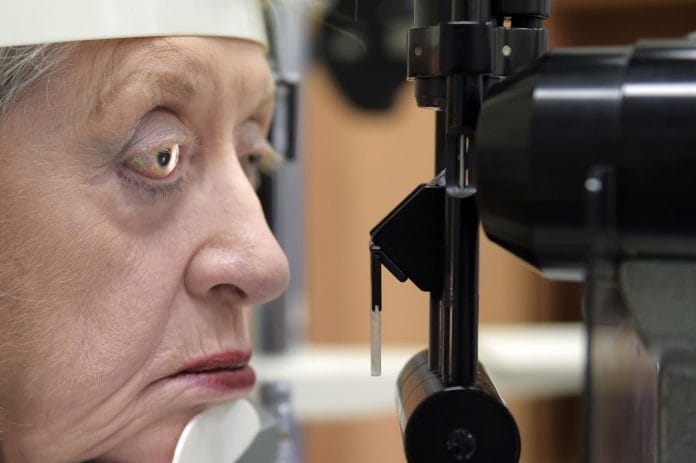Projected to affect about 80 million people by 2020, the condition causes progressive loss of peripheral vision which ultimately leads to blindness.
Caroline Tupcienko would rather have a needle in her eye than tilt her head back for drops several times a day to prevent the blinding effects of glaucoma.
The 73-year-old received an experimental ocular implant in July, the first of its kind that dispenses a constant daily dose of medicine as it dissolves over six months. The rod-shaped device – made by Melbourne-based PolyActiva Pty Ltd. and inserted via a fine needle through the cornea into the front of the eye – represents the vanguard of therapies promising to improve treatment for glaucoma, the most common cause of irreversible blindness.
“This is so much better,” Tupcienko said at a checkup four weeks after what she described as an “absolutely painless,” 20-second procedure. “You would never know I had it.” The implant, smaller than an eyelash, means she can skip as many as four daily sessions with a bottle of eye drops, she said.
Glaucoma occurs when the optic nerve becomes damaged, usually after defective plumbing in the eye creates excess fluid and pressure. Projected to afflict 80 million people worldwide by 2020, the condition causes progressive loss of peripheral vision if left untreated, leading to tunnel vision and ultimately blindness.
Unfortunately, many sufferers don’t like to drip medicine into their eyes. While drops like Pfizer Inc.’s Xalatan lower nerve-damaging pressure, numerous studies have found poor compliance among patients, who find dribbling the drugs from overhead multiple times a day to be inconvenient, cumbersome and easy to forget.
Drop-Free
It’s “the No. 1 problem in glaucoma management,” said Bill Meury, chief commercial officer of Allergan Inc., on a conference call in July. The company is also developing an implant aimed at solving “compliance with these eye drops, which most people don’t take and even when they do take it, they don’t take them properly and it can chew up the surface of the eye.”
Companies are streaming into the field with drop-free treatments. Over the next several years, at least five new products will drive an annual 4.1 per cent expansion in glaucoma product sales across major markets through 2026, according to London-based researcher GlobalData Plc.
Glaucoma drug sales may reach $6.6 billion worldwide by 2023, from $4.8 billion this year, Market Scope LLC predicted in June. The St. Louis-based researcher counts 16 new agents and 10 alternative drug-delivery platforms in clinical development, with another nine drug-delivery research programs underway at universities around the world.
New Therapies
“Glaucoma is going through a huge resurgence,” said Nathan Kerr, a Melbourne glaucoma surgeon at the Center for Eye Research Australia, who’s leading a study of PolyActiva’s device. “There’s been a paradigm shift in treatment, moving towards drop-free therapy.”
Tupcienko’s eye has tolerated the PolyActiva implant “beautifully,” while lowering pressure inside her eye at least as much the drops she was using, Kerr said. Such successes are inspiring researchers to pursue the technique for administering antibiotics, steroids and other types of medication, he said.
About a dozen stents, shunts and other alternative ways to lower eye pressure have already reached the market. Santen Pharmaceutical Co. applied in November for approval to sell its InnFocus MicroShunt in Japan and plans to launch the implanted drainage device in the United States (US) by 2021. Annual sales could exceed $200 million within about five years of the move, said Christopher Hohman, a spokesman for Santen.
The Osaka-based company has doubled its revenue from glaucoma treatments over the past five years, and is hoping for Japanese approval by December to sell DE-117, a novel pressure-lowering medication that’s administered by a single eye drop daily, Hohman said in an email.
Top Sellers
Drugs from Allergan and Aerie Pharmaceuticals Inc. will be among the top sellers in the glaucoma market, GlobalData health care analyst Thomas Moore said in February. Allergan reported positive results from a late-stage study in June and will file in the second half of 2019 for US approval of Bimatoprost SR, its sustained-release, biodegradable implant.
Aerie is looking for mid-March clearance of Roclatan, a treatment combining the key ingredient of its newly approved once-daily, single eye drop Rhopressa with the active ingredient in Pfizer’s Xalatan. Roclatan’s annual sales will peak at $631.9 million by 2026, while Bimatoprost SR’s will hit $609.5 million during the same period, Moore said.
Even as glaucoma treatment improves, a cure has remained elusive. The condition’s underlying cause may be an immune system malfunction that’s triggered by bacteria, according to researchers led by Dong Feng Chen, a Harvard University associate professor of ophthalmology. A drug that inhibits an overzealous immune response might stop glaucoma in its tracks, she said.
Radical Change
“This can radically change the way glaucoma is treated,” Chen, who’s also at the Schepens Eye Research Institute of Massachusetts Eye and Ear, said in an email. “Targeting the autoimmune pathway in glaucoma patients, based on our finding, should provide a cure for the disease.”
Chen’s lab in Boston is exploring experimental drugs that target T cells in the retina, a part of the eye where the immune cells aren’t supposed to be present.
The widespread use of eye injections and implants “opens the door for potential interventions targeting T cells in the eyes of patients with glaucoma,” she said.
That’s encouraging for sufferers like Tupcienko, who was motivated to participate in the implant trial after living with glaucoma for more than three years. “I feel very privileged, hoping I can help other people,” she said.- Bloomberg






